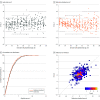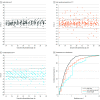Diagnostic Accuracy of an Integrated AI Tool to Estimate Gestational Age From Blind Ultrasound Sweeps
- PMID: 39088200
- PMCID: PMC11350478
- DOI: 10.1001/jama.2024.10770
Diagnostic Accuracy of an Integrated AI Tool to Estimate Gestational Age From Blind Ultrasound Sweeps
Abstract
Importance: Accurate assessment of gestational age (GA) is essential to good pregnancy care but often requires ultrasonography, which may not be available in low-resource settings. This study developed a deep learning artificial intelligence (AI) model to estimate GA from blind ultrasonography sweeps and incorporated it into the software of a low-cost, battery-powered device.
Objective: To evaluate GA estimation accuracy of an AI-enabled ultrasonography tool when used by novice users with no prior training in sonography.
Design, setting, and participants: This prospective diagnostic accuracy study enrolled 400 individuals with viable, single, nonanomalous, first-trimester pregnancies in Lusaka, Zambia, and Chapel Hill, North Carolina. Credentialed sonographers established the "ground truth" GA via transvaginal crown-rump length measurement. At random follow-up visits throughout gestation, including a primary evaluation window from 14 0/7 weeks' to 27 6/7 weeks' gestation, novice users obtained blind sweeps of the maternal abdomen using the AI-enabled device (index test) and credentialed sonographers performed fetal biometry with a high-specification machine (study standard).
Main outcomes and measures: The primary outcome was the mean absolute error (MAE) of the index test and study standard, which was calculated by comparing each method's estimate to the previously established GA and considered equivalent if the difference fell within a prespecified margin of ±2 days.
Results: In the primary evaluation window, the AI-enabled device met criteria for equivalence to the study standard, with an MAE (SE) of 3.2 (0.1) days vs 3.0 (0.1) days (difference, 0.2 days [95% CI, -0.1 to 0.5]). Additionally, the percentage of assessments within 7 days of the ground truth GA was comparable (90.7% for the index test vs 92.5% for the study standard). Performance was consistent in prespecified subgroups, including the Zambia and North Carolina cohorts and those with high body mass index.
Conclusions and relevance: Between 14 and 27 weeks' gestation, novice users with no prior training in ultrasonography estimated GA as accurately with the low-cost, point-of-care AI tool as credentialed sonographers performing standard biometry on high-specification machines. These findings have immediate implications for obstetrical care in low-resource settings, advancing the World Health Organization goal of ultrasonography estimation of GA for all pregnant people.
Trial registration: ClinicalTrials.gov Identifier: NCT05433519.
Conflict of interest statement
Figures



Comment in
-
Enhancing Obstetric Ultrasonography With Artificial Intelligence in Resource-Limited Settings.JAMA. 2024 Aug 27;332(8):626-628. doi: 10.1001/jama.2024.14794. JAMA. 2024. PMID: 39088222 Free PMC article. No abstract available.
References
-
- World Health Organization . WHO recommendations on antenatal care for a positive pregnancy experience. 2016.Accessed March 15, 2018. https://apps.who.int/iris/bitstream/10665/250796/1/9789241549912-eng.pdf... - PubMed
Publication types
MeSH terms
Associated data
LinkOut - more resources
Full Text Sources
Medical
Miscellaneous

